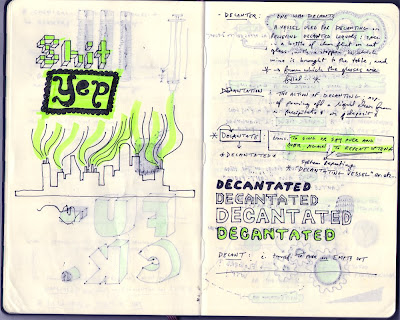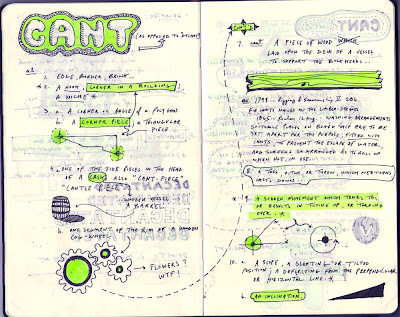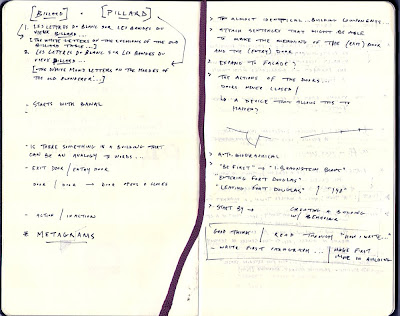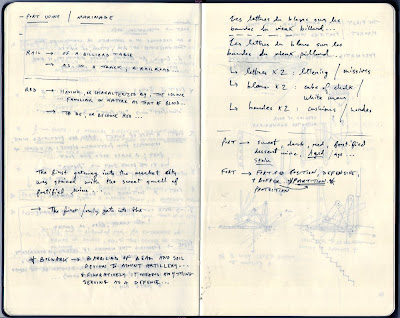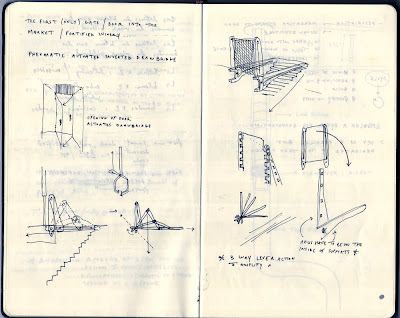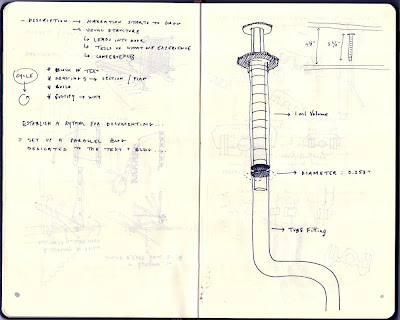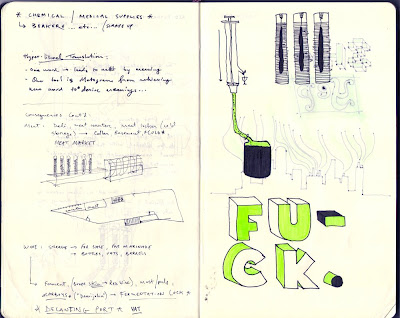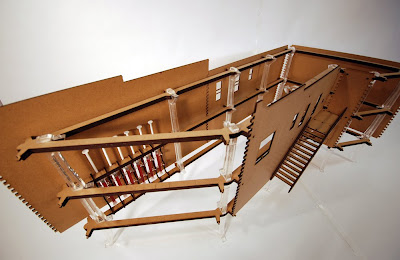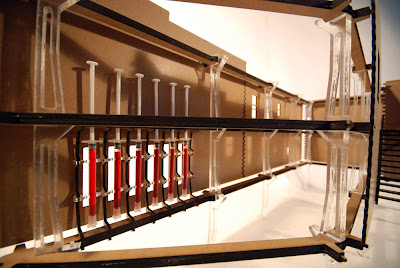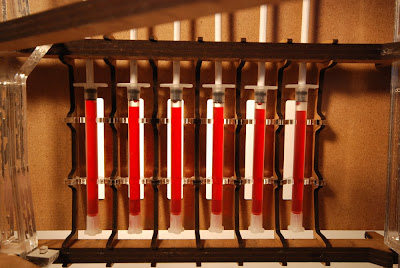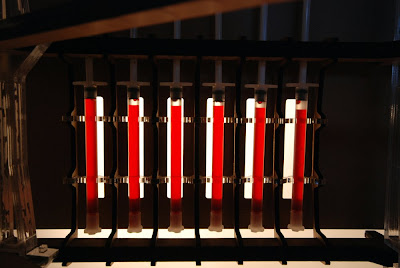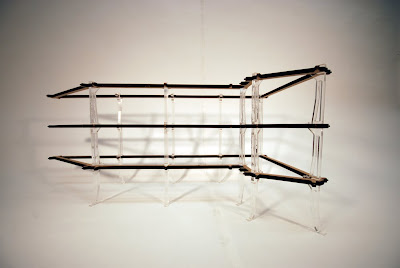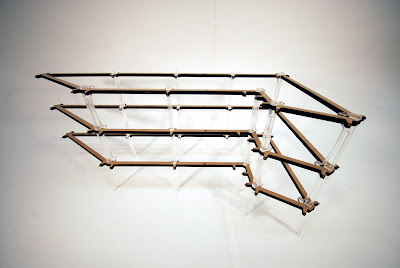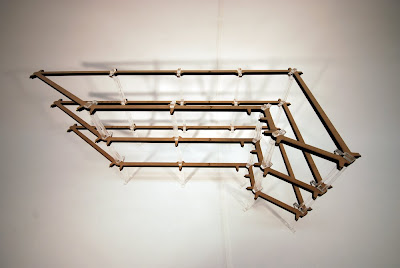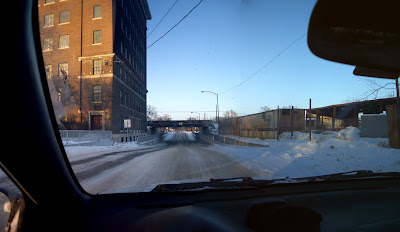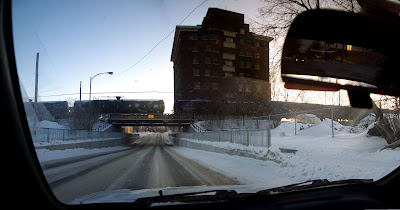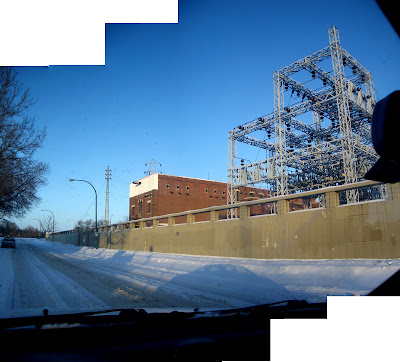Friday, July 11, 2008
Wednesday, April 9, 2008
Tuesday, April 8, 2008
Monday, April 7, 2008
The First Gate...
The First Gate...
Wednesday, March 26, 2008
Roussel's Method
Hopper
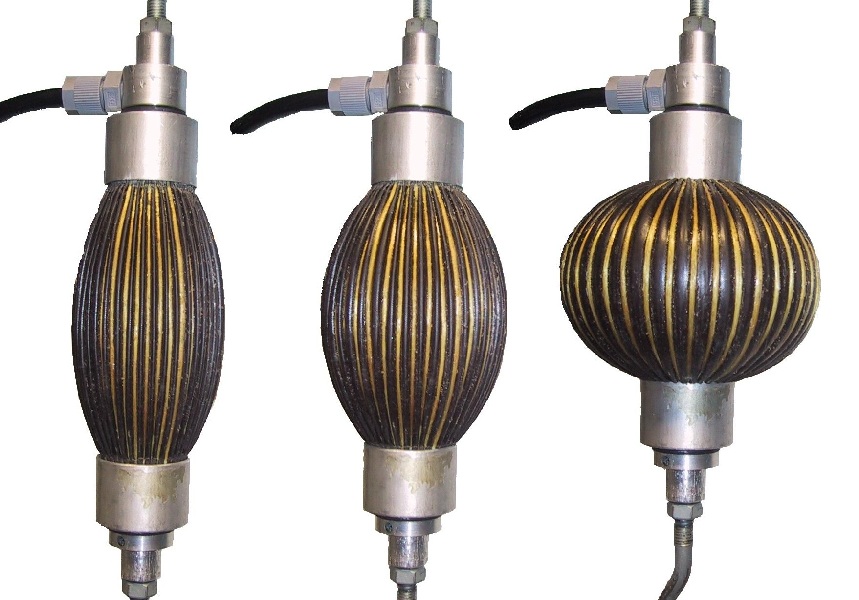
A pneumatic artificial muscle is, in essence, a membrane that will expand radially and contract axially when inflated, while generating high pulling forces along the longitudinal axis. Different designs have been developed. The best known is the so called McKibben muscle (example is the Air Muscle of the Schadow Robot Company). This muscle contains a rubber tube which will expand when inflated, while a surrounding netting transfers tension. Hysteresis, due to dry friction between the netting and the rubber tube, makes control of such a device rather complicated. Typical of this type of muscles is a threshold level of pressure before any action can take place. The main goal of the new design was to avoid both friction and hysteresis, thus making control easier while avoiding the threshold. This was achieved by arranging the membrane into radially laid out folds that can unfurl free of radial stress when inflated. The membrane's stiff longitudinal fibres transfer tension. The inflated and deflated state of the Pleated Pneumatic Artificial Muscle are illustrated below.
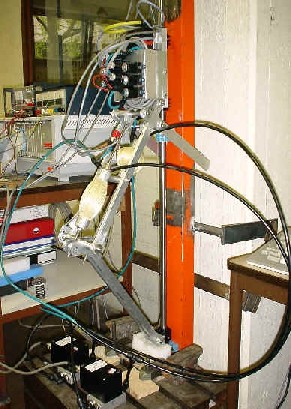
These artificial muscles have specific properties that are of special interest in the field of legged robots:
- High torque/weight and power/weight ratios
- Muscles’ natural compliance
- The actuator can be positioned at the joint without complex gearing mechanisms
- Adaptable passive behaviour suited for energy storage >
- Shock absorbance during impact.>
The generated force is highly non-linear and proportional to the applied gauge pressure in the muscle. At a pressure of 300 kPa the force can be as high as 4000N for a device with initial length of 10cm, weighing only 100g.
Pneumatic artificial muscles only generate force when they shorten. To have a bi-directional working joint one has to couple two muscles antagonistically. At each joint the muscles are attached in a leverage mechanism by pulling rods. The points of attachment are essential in the design since they determine torque characteristics.
In an antagonistic setup without external load, position will be determined by the ratio of pressures in both muscles. In previous work (Daerden) a revolute joint was build for rotations between -30° and 30°. A step response from 0° to 10° was achieved with end error within 0.1° and overshoot less than 1° making use of proportional valves to control both pressures.
The artificial muscle is inherently compliant due to gas compressibility and the dropping force-contraction curve. In an antagonistic setup compliance is determined by the sum of the pressures in both muscles, therefore both position and stiffness can be controlled.
To investigate this, a hopping mechanism (see picture above) composed of a lower leg, upper leg, hip and body sliding along a guide shaft was built. Only the knee is actuated by a pair of artificial muscles. During experiments the leg was dropped from a fixed height while both muscles were kept closed. During stance, the leg will bend and stretch the extensor muscle. In this muscle, pressure and forces will increase as it extends, which implies that the extensor muscle stores motion energy that will be released as soon as the leg starts straightening. During these tests energy recuperation of up to 30% is registered.
More information on this topic can be found in (Verrelst e.a. clawar 2000)
Saturday, March 22, 2008
Metagrams
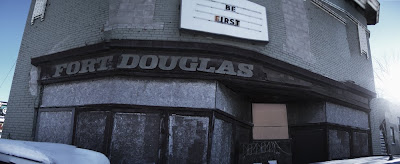
"Fort Douglas"
Fort (from www.dictionary.com)
–noun
| 1. | a strong or fortified place occupied by troops and usually surrounded by walls, ditches, and other defensive works; a fortress; fortification. |
| 2. | any permanent army post. |
| 3. | (formerly) a trading post. |
| 4. | hold the fort,
|
| -- noun | |
| 1. | a fortified military post where troops are stationed [syn: garrison] |
| 2. | a fortified defensive structure [syn: fortress] |
verb | |
| 1. | gather in, or as if in, a fort, as for protection or defense |
| 2. | enclose by or as if by a fortification [syn: fortify] |
| 3. | station (troops) in a fort |
from the Oxford English Dictionary:
Noun 1
1. Mil. A fortified place; a position fortified for defensive or protective purposes, usually surrounded with a ditch, rampart, and parapet, and garrisoned with troops; a fortress.
b. fig. A strong position, stronghold. Phr. to hold the fort: to act as a temporary substitute; also, to remain at one's post, to maintain one's position, to ‘cope’.
c. In British North America and parts of the U.S.: A trading station (originally fortified).
2. The place of security (of a wild animal).
4. Strong part or point. Now written FORTE, q.v.
--
Noun 2
1867 FRY Playing-Card Terms in Philol. Soc. Trans. 56 Fort, an oiled sheet, (usually large enough for twenty cards) formerly used in making the stencilling-plate for stencilling the colors of the court-cards or the pips of the other cards.
Saturday, February 2, 2008
Technology Absurdity... Absurdity of Technology
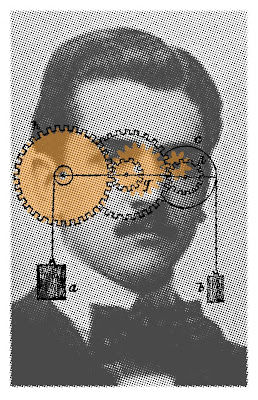 I am tentatively calling my project for this term Technology Absurdity... Absurdity of Technology.
I am tentatively calling my project for this term Technology Absurdity... Absurdity of Technology. Dwarves that sweat blood. Inflatable devices which utilize the magnetic properties of mysterious alloys to extract loose teeth. 20 seconds of resurrection.
These are the absurdities which Raymond Roussel creates in Locus Solus. But they become believable absurdities. Roussel confronts technology and reality through, seemingly, nonsensical stories. Technology is used to explain or justify his tales - although the technology is just as absurd as the stories. But is it? Every object and consequence depicted throughout the novel is riddled with layers of complex history and Roussel's mythology. But is it? What is real and what is not? What is possible and what is not?
Roussel's construction of language is extremely puzzling at first. It is as if you are reading an extremely bizarre, vivid and rich dream sequence. That is probably the best way I can try to explain it. His method in presenting each story is what I propose to adopt for my method of working for the term. As mentioned, he sets up each story in a manner of which the reader is experiencing it for the first time with no context or history. Roussel then retraces the absurdity and vivisects every layer of history and every consequence within. This makes for a very rich way of construcing a myth.
It would probably help here to have an example of what I am describing. I will scan a few pages and post them up to give you a better idea.
My site for the term will be the Kings Hotel and / or the Fort Douglas building in Point Douglas.
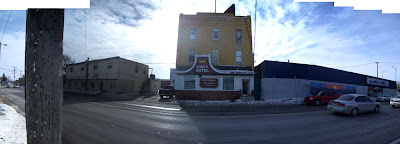
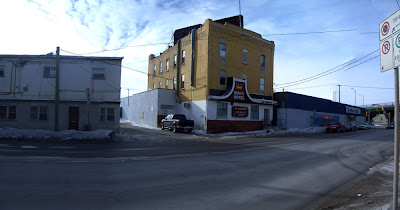
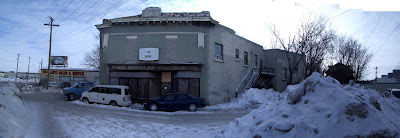

Both sites offer a lot of potential for "myth making". The Kings hotel with its temporary residents and Fort Douglas with its interesting context.
I will post more later to expand on these thoughts.
Tuesday, January 29, 2008
The Bride Stripped Bare
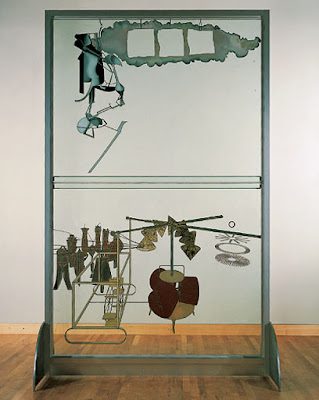 From Linda Dalryple Henderson's Marcel Duchamp's The King and Queen Surrounded by Swift Nudes (1912) and the Invisible World of Electrons. Found here.
From Linda Dalryple Henderson's Marcel Duchamp's The King and Queen Surrounded by Swift Nudes (1912) and the Invisible World of Electrons. Found here.In The Bride Stripped Bare by Her Bachelors, even Duchamp sought to create a humorous "reality which would be possible by slightly distending the laws of physics and chemistry," as he described it in one of his notes (Writings 71). For this elaborate allegory of quest, Duchamp drew on science and technology as well as geometry to create the "collisions" between the incommensurable realms of the three-dimensional, gravity bound Bachelors below and a four-dimensional etherial Bride above. The complex scenario of the Large Glass is filled with ballistic collisions at all scales--from subatomic and molecular to the impact of the Nine Shots aimed at the "target" in the Bride's realm. In contemporary work on the kinetic theory of gases, for example, Duchamp would have found both a scientific analogue for his own growing interest in chance and a model of incessant collision, documented convincingly in this period by the work of Jean Perrin on Brownian motion. Like the molecular drama he enacts in the context of the liquefaction of the Bachelors' semen-like "Illuminating Gas," many of the events of the "Playful Physics" of the Glass are scientific metaphors for the overarching collision between the desire of the Bachelors and the position of the Bride, high above them and forever beyond their reach.
Monday, January 28, 2008
hanabi
From the website:
The heat of the bulb makes this shape-memory alloy lamp "bloom" whenever the light is turned on. "hanabi", the Japanese word for “fireworks”, literally means "flower + fire." Both flowers and fire fade away so quickly and easily. Like its namesake, this light flickers between beauty and disappearance.




